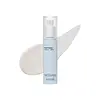What's inside
What's inside
 Key Ingredients
Key Ingredients

 Benefits
Benefits

No benefits
 Concerns
Concerns

 Ingredients Side-by-side
Ingredients Side-by-side

Cyclopentasiloxane
EmollientDimethicone
EmollientDimethicone/Vinyl Dimethicone Crosspolymer
Skin ConditioningMethyl Trimethicone
Skin ConditioningPolymethylsilsesquioxane
Silica
AbrasiveCaprylyl Methicone
Skin ConditioningDisteardimonium Hectorite
StabilisingPEG-10 Dimethicone
Skin ConditioningVinyl Dimethicone/Methicone Silsesquioxane Crosspolymer
Tocopheryl Acetate
AntioxidantDiisostearyl Malate
EmollientCI 77891
Cosmetic ColorantTriethyl Citrate
MaskingSilica Silylate
EmollientCyclopentasiloxane, Dimethicone, Dimethicone/Vinyl Dimethicone Crosspolymer, Methyl Trimethicone, Polymethylsilsesquioxane, Silica, Caprylyl Methicone, Disteardimonium Hectorite, PEG-10 Dimethicone, Vinyl Dimethicone/Methicone Silsesquioxane Crosspolymer, Tocopheryl Acetate, Diisostearyl Malate, CI 77891, Triethyl Citrate, Silica Silylate
Cyclopentasiloxane
EmollientDimethicone
EmollientDimethicone/Vinyl Dimethicone Crosspolymer
Skin ConditioningCyclohexasiloxane
EmollientSilica
AbrasivePolymethylsilsesquioxane
Dimethicone/PEG-10/15 Crosspolymer
Parfum
MaskingPolymethyl Methacrylate
Water
Skin ConditioningMineral Salts
Skin ConditioningTriethoxycaprylylsilane
Propanediol
SolventMentha Arvensis Leaf Extract
Masking1,2-Hexanediol
Skin ConditioningPhenoxyethanol
PreservativeOpuntia Coccinellifera Fruit Extract
Skin ConditioningAluminum Hydroxide
EmollientCI 77891
Cosmetic ColorantSodium Citrate
BufferingOrchid Extract
Skin ConditioningCamellia Sinensis Leaf Extract
AntimicrobialCI 77491
Cosmetic ColorantDiospyros Kaki Fruit Extract
Skin ConditioningCI 77492
Cosmetic ColorantCI 77499
Cosmetic ColorantCitrus Unshiu Peel Extract
MaskingEthylhexylglycerin
Skin ConditioningMica
Cosmetic ColorantCamellia Japonica Leaf Extract
Skin ConditioningTitanium Dioxide
Cosmetic ColorantLinalool
PerfumingButylene Glycol
HumectantLimonene
PerfumingTocopherol
AntioxidantDipropylene Glycol
HumectantCyclopentasiloxane, Dimethicone, Dimethicone/Vinyl Dimethicone Crosspolymer, Cyclohexasiloxane, Silica, Polymethylsilsesquioxane, Dimethicone/PEG-10/15 Crosspolymer, Parfum, Polymethyl Methacrylate, Water, Mineral Salts, Triethoxycaprylylsilane, Propanediol, Mentha Arvensis Leaf Extract, 1,2-Hexanediol, Phenoxyethanol, Opuntia Coccinellifera Fruit Extract, Aluminum Hydroxide, CI 77891, Sodium Citrate, Orchid Extract, Camellia Sinensis Leaf Extract, CI 77491, Diospyros Kaki Fruit Extract, CI 77492, CI 77499, Citrus Unshiu Peel Extract, Ethylhexylglycerin, Mica, Camellia Japonica Leaf Extract, Titanium Dioxide, Linalool, Butylene Glycol, Limonene, Tocopherol, Dipropylene Glycol
 Reviews
Reviews

Ingredients Explained
These ingredients are found in both products.
Ingredients higher up in an ingredient list are typically present in a larger amount.
Ci 77891 is a white pigment from Titanium dioxide. It is naturally found in minerals such as rutile and ilmenite.
It's main function is to add a white color to cosmetics. It can also be mixed with other colors to create different shades.
Ci 77891 is commonly found in sunscreens due to its ability to block UV rays.
Learn more about CI 77891Cyclopentasiloxane, or D5, is a silicone used to improve texture of products and trap moisture.
D5 is considered lightweight and volatile. Volatile means it evaporates quickly after application. Once evaporated, D5 leaves a thin barrier that helps keep skin hydrated.
It is also an emollient. Emollients help soften the skin and prevent water loss. Silicones create a silky texture in products. D5 helps other ingredients become more spreadable.
Studies show D5 is safe to use in skincare products. We recommend speaking with a skincare professional if you have concerns.
Learn more about CyclopentasiloxaneDimethicone is a type of synthetic silicone created from natural materials such as quartz.
What it does:
Dimethicone comes in different viscosities:
Depending on the viscosity, dimethicone has different properties.
Ingredients lists don't always show which type is used, so we recommend reaching out to the brand if you have questions about the viscosity.
This ingredient is unlikely to cause irritation because it does not get absorbed into skin. However, people with silicone allergies should be careful about using this ingredient.
Note: Dimethicone may contribute to pilling. This is because it is not oil or water soluble, so pilling may occur when layered with products. When mixed with heavy oils in a formula, the outcome is also quite greasy.
Learn more about DimethiconeThis ingredient is a silicone used to improve the texture of products and absorb oil. It does not get absorbed into the skin.
Like other silicones, Dimethicone/Vinyl Dimethicone Crosspolymer helps condition the skin by creating a barrier. In this sense, it can act as an emollient and trap moisture in.
This ingredient is a type of elastomer.
Learn more about Dimethicone/Vinyl Dimethicone CrosspolymerPolymethylsilsesquioxane is a silicone used as a film forming agent.
When applied to the skin, this ingredient creates an invisible film on the surface. This film still allows oxygen to pass through, but prevents moisture from escaping. This can help condition and hydrate the skin. It also leaves a silky feel when applied.
Polymethylsilsesquioxane has not been shown to clog pores. It has been deemed safe to use up to 55%, but most cosmetics use much less.
If you have concerns about using this ingredient, we recommend speaking with a professional.
Learn more about PolymethylsilsesquioxaneSilica, also known as silicon dioxide, is a naturally occurring mineral. It is used as a fine, spherical, and porous powder in cosmetics.
Though it has exfoliant properties, the function of silica varies depending on the product.
The unique structure of silica enhances the spreadability and adds smoothness, making it a great texture enhancer.
It is also used as an active carrier, emulsifier, and mattifier due to its ability to absorb excess oil.
In some products, tiny microneedles called spicules are made from silica or hydrolyzed sponge. When you rub them in, they lightly polish away dead skin layers and enhance the penetration of active ingredients.
Learn more about Silica